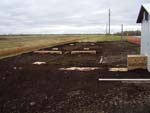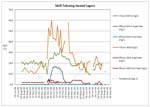
Submerged Attached Growth Reactors
- By Mark O. Liner, P.E., Merle Kroeker, P.E.
- Mar 22, 2010
In the past five years, aerated gravel beds have been adapted to form Submerged Attached Growth Reactors (SAGRs). Typically located downstream of primary lagoons or other primary treatment systems, SAGRs are aerated coarse-gravel beds now being used to achieve ammonia limits.
With minimal mechanical equipment or new infrastructure, SAGRs can be easily integrated into lagoon systems. Portions of existing lagoons can be modified or abandoned lagoons easily retrofitted to transform them into simple aerobic polishing filters. The use of a simple aeration system, similar to those already used for aerating lagoons, provides an added element of process stability, leading to treatment performance not commonly experienced in conventional lagoons.
With SAGRs, the bed aggregate provides a foothold for bacteria to stay resident in the bed and not wash away in the effluent. Because lagoons reduce organic and suspended solids loads upstream, a stable nitrifier population can be established on the aggregate with limited competition from space-hogging heterotrophic bacteria. Nitrification in attached growth systems is known to flourish when biochemical oxygen demand (BOD) concentrations are less than 25 mg/L. Moreover, the bed design minimizes the mass flux of organics (lb-BOD/sf/d) to levels that prevent long-term fouling. Finally, a step-feed mode of operation protects the nitrifying bacteria from winter-time encroachment of heterotrophic bacteria.
Steinbach, Manitoba, Canada Nelson Environmental Inc. constructed a SAGR facility in Steinbach, Manitoba to demonstrate consistent, cold-weather nitrification. Steinbach has long, cold winters, and its single-cell uncovered aerated lagoon experiences elevated effluent BOD and ammonia concentrations during winter (28 days of retention time). The demonstration facility, which has been in operation since 2007, is located next to the aerated lagoons.
The facility has two parallel treatment flow streams or trains, each consisting of two aerated, submerged gravel beds in series. Each train receives 5,000 gallons per day (19 m3/d) of lagoon effluent with winter-time water temperatures as low as 32 degrees Fahrenheit (0.2 degrees Celsius). Train No.1 receives flow at the front of the train year round. Train No. 2 operates as a step feed system, receiving flow at the midpoint of the train during fall months and at the front of the train during the remainder of the year. Insulating mulch protects the process flow from freezing.
The step feed system promotes nitrifier growth in the secondary zone during warmer months when influent organic loadings are lower. In winter, when five-day BOD (BOD5) in the lagoon effluent typically rises and heterotrophic encroachment occurs, the system diverts the influent to the front of the train to accommodate the seasonal fluctuation of bacterial activity. Nine temperature loggers throughout the beds and the influent streams record hourly measurements. Operators conduct water sampling from ports at the middle and end of both treatment trains and from the influent water flow for a total of five sample sites. An automatic composite sampler collects influent water over a 24-hour period. Operators take grab samples from the water ports using a peristaltic pump.
An independent laboratory receives the water chemistry samples within four hours of collection. These samples were analyzed for total alkalinity, BOD5, cBOD5 (carbonaceous BOD), ammonia-nitrogen, total Kjeldahl nitrogen (TKN), total nitrogen, nitrates, total suspended solids, total phosphorous, turbidity, and pH (see the table). Samples also were tested for total and fecal coliforms and E.coli. This sampling program continued throughout winter with minor changes.

Water sample results. Click on the image for a PDF of the table.
In lagoons, nitrification typically happens near the back of the system once influent BOD levels and their heterotrophic bacteria growth have been reduced. This allows for ammonia removal in summer in many lagoon systems, but in winter, the lagoon water temperature is too cold for conventional nitrification systems to be effective by the time the BOD is removed. The Steinbach system has established the ability to remove ammonia at water temperatures as low as 32 degrees Fahrenheit (0.2 Celsius) per milligrams per liter, allowing for the use of SAGRs following a conventional lagoon. Use of step feed redistributes the higher organic loading and related heterotrophic growth to the front of the beds during colder temperatures. This preserves the nitrification zone at the back of the beds from encroachment by organics and heterotrophic bacteria. Maintaining a distinct nitrification zone free of cBOD allows the system to consistently achieve ammonia levels below 1 mg/L, regardless of influent water temperatures.

The graph displays the concentrations of cBOD5, ammonia (NH4-N) and temperatures measured in the SAGR influent and effluent streams over the 2008 and 2009 results. Click on the image for a PDF of the graph.
Influent temperatures dropped close to freezing around Nov. 22, 2008 and stayed low until late March, 2009. As soon as the water temperature dropped below 33.9 degrees Fahrenheit (1 degree Celsius), operators noticed an increase in BOD concentration from the aerated lagoon that correlates with an increase in effluent ammonia in the single feed control train. The loss of nitrification may be due to the encroachment of attached growth heterotrophs into the nitrification zone. The heterotrophs are known to out-compete nitrifiers for space in attached growth systems, when organic loadings are above 27 mg/L as chemical oxygen demand. Comparison of the influent cBOD values against the effluent NH4-N values clearly supports this theory.
When used as an extension to wastewater treatment lagoons, SAGR is exceeding performance expectations. Several specific conclusions about SAGRs can be drawn following year two of testing at Steinbach:
- A properly designed SAGR can provide full ammonia removal after a lagoon in cold climate applications. At Steinbach, effluent ammonia and cBOD5 from the uncovered lagoon followed by a SAGR were below detection through much of the winter.
- A step feed system is necessary to provide full nitrification when fluctuating cBOD5 levels follow an aerated lagoon with water temperatures below 32.9 degrees Fahrenheit (0.5oC).
- Insulated covers on the lagoon are not necessary to achieve full nitrification.
- The SAGR effectively polishes secondary wastewater effluent. Effluent cBOD5 levels were below 5 mg/L in the system effluent regardless of the season.
- Effluent TSS levels were below 10 mg/L and typically below detection.
Traditionally when nutrient removal has been required, lagoon infrastructure has been abandoned in favor of mechanical treatment plants with not only high capital cost implications but also significant long-term operation and maintenance costs. Cities and towns may need to find alternative approaches that work and protect public health. Nutrient removal with a lagoon-based wastewater treatment system offers another option that is growing in acceptance because it presents significant long term cost savings, ease of operation, and treatment effectiveness for many small- to medium-sized communities.
References
Grady, Daigger, and Lim, Biological Wastewater Treatment, Marcel Decker, New York, 1999.
Kadlec and Wallace, Treatment Wetlands, CRC Press, Boca Raton, 2009.
About the Authors
Mark O. Liner, P. E., is a senior engineer with Naturally Wallace Consulting. Over his 20-year career, he has worked as a regulator at U.S. EPA headquarters in Washington, D.C., as a process and equipment supplier for wastewater treatment systems, as a design-build project manager for a $20 million sewage plant in Venezuela, and as a consultant engineer for municipal and industrial clients. He specializes in the design of onsite treatment systems for industrial facilities with an emphasis on airport deicing, mines, landfill leachate, and remediation.
Merle Kroeker, P. Eng., is a project development engineer with Nelson Environmental Inc. His experience includes wastewater treatment system process design and optimization and he has been involved in projects across North America, including those in lagoon-based municipal and industrial wastewater treatment systems, stormwater treatment, and raw water reservoir improvements. His current focus is on post lagoon cold climate ammonia removal, for new or upgrades of existing lagoon wastewater treatment systems. He graduated from the University of Manitoba with a degree in biosystems engineering.